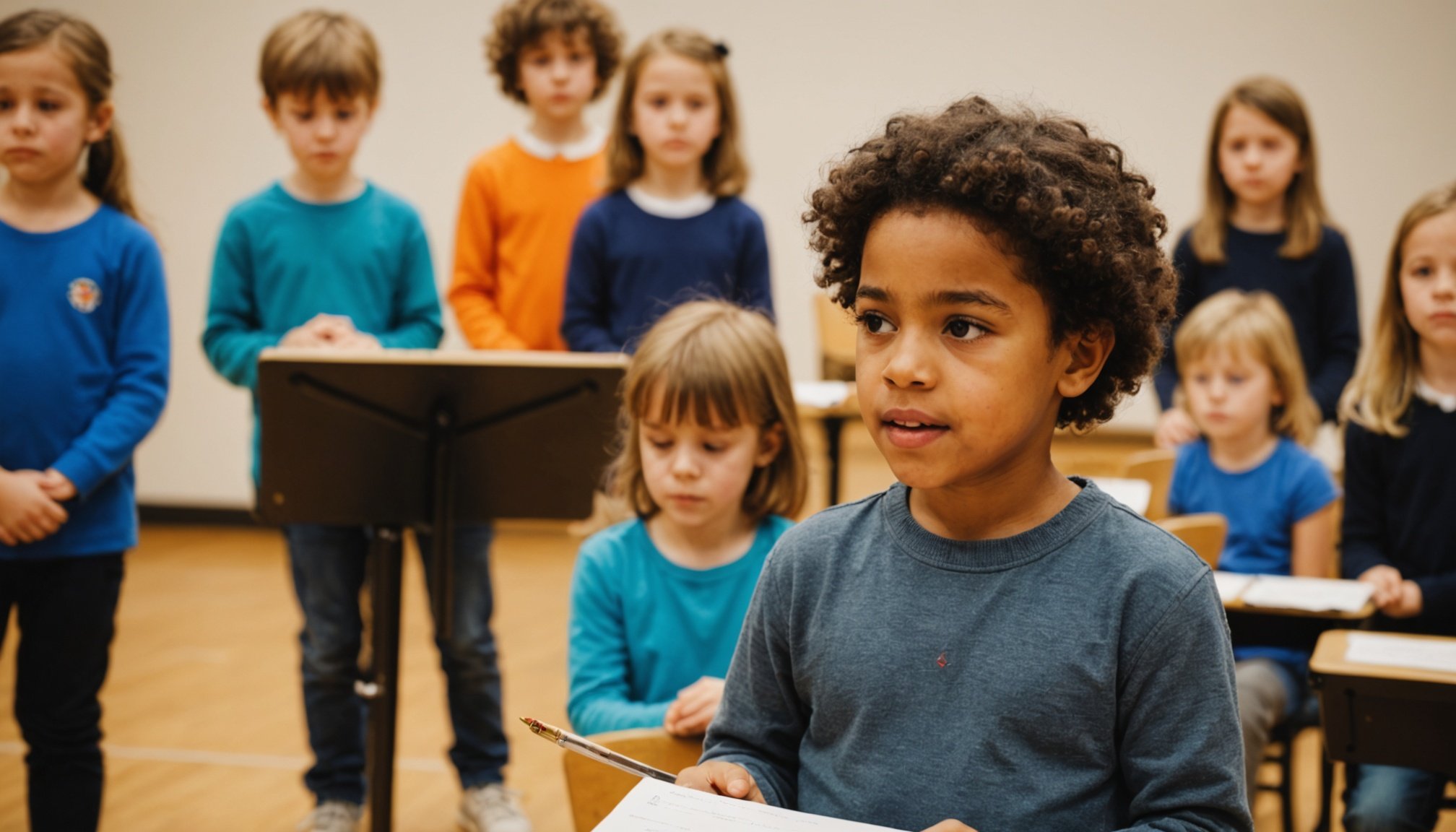Unlocking Emotions: The Impact of Performing Arts on Children’s Emotional Growth
When we think about the development of children, we often focus on their academic and physical growth. However, their emotional development is just as crucial, and one of the most effective ways to nurture this is through the performing arts. In this article, we will delve into how activities like music, dance, theater, and visual arts can profoundly impact a child’s emotional growth.
Why Emotional Development Matters
Emotional development is the foundation upon which children build their ability to understand, manage, and express their emotions. This skill is essential for their overall well-being and for forming healthy relationships with others.
In the same genre : Discover stylish orthopedic shoes for women's comfort today
For Children
Developing emotional intelligence from an early age equips children with the tools to navigate the challenges of childhood, such as school pressures, adolescent turmoil, and social difficulties. It helps them integrate into groups, establish strong friendships, and feel confident in their own skin. Emotional intelligence also aids in managing daily stress, contributing to long-term well-being[1].
How Performing Arts Foster Emotional Growth
Performing arts are more than just creative outlets; they are powerful tools for emotional development.
In the same genre : Discover How Aromatherapy Can Boost Your Mood and Alleviate Stress: Unveiling Its Transformative Benefits
Connection with Emotions
Engaging in performing arts allows children to connect with their emotions in a deep and authentic way. For instance, singing a song or acting in a play requires drawing from personal emotional experiences. This process helps children understand what they feel and provides a safe space to explore their emotions without judgment.
- Music: Playing an instrument or singing can help children identify and accept complex emotions like sadness or frustration. It transforms these emotions into creative energy, teaching them to channel their feelings constructively[1].
- Dance: Through dance, children can express emotions physically, which can be particularly helpful for those who struggle with verbal communication. It allows them to convey feelings in a non-verbal yet powerful way.
- Theater: Acting in a play or skit enables children to explore different emotional roles, helping them understand various perspectives and empathize with others.
Learning Emotional Regulation
Participating in artistic activities teaches children how to manage their emotions effectively. Here are some ways this happens:
- Constructive Expression: Engaging in artistic activities helps children express their emotions in a constructive manner. For example, an adult who sings to relieve stress discovers a positive way to handle overwhelming feelings. Instead of suppressing emotions, they transform them into creative energy, which not only makes them feel better but also teaches them to channel their emotions to avoid destructive outcomes[1].
- Self-Awareness: Performing arts encourage children to become more aware of their emotions. By exploring different roles or expressing themselves through art, they gain a better understanding of what they feel and why.
Practical Benefits of Performing Arts
The benefits of performing arts on children’s emotional development are multifaceted and far-reaching.
Enhanced Self-Esteem
- Confidence Boost: Performing in front of an audience, whether it’s a school play or a music recital, can significantly boost a child’s self-esteem. The applause and positive feedback they receive can make them feel valued and appreciated.
- Achievement: Completing a creative project or performing a role successfully gives children a sense of accomplishment, which is crucial for building self-esteem.
Improved Social Skills
- Teamwork: Many performing arts activities, such as theater or dance, require teamwork. Children learn to collaborate, communicate effectively, and rely on each other to achieve a common goal.
- Empathy: By playing different roles or expressing various emotions through art, children develop empathy and understanding of others’ feelings.
Better Mental Health
- Stress Relief: Engaging in creative activities is a proven way to reduce stress and anxiety. Children who participate in performing arts often find it easier to manage their emotions and cope with stressful situations.
- Emotional Regulation: Performing arts help children develop better emotional regulation skills. This means they are more likely to handle their emotions in a healthy way, reducing the risk of mental health issues like depression and anxiety[2].
Table: Comparing the Impact of Different Performing Arts on Emotional Development
| Performing Art | Emotional Benefits | Social Benefits | Mental Health Benefits |
|---|---|---|---|
| Music | Identifies and accepts complex emotions, transforms emotions into creative energy | Encourages teamwork in bands or choirs, develops communication skills | Reduces stress, improves mood, enhances cognitive functions[1] |
| Dance | Expresses emotions physically, enhances self-awareness | Fosters teamwork in dance groups, improves social skills | Reduces anxiety, improves body image, enhances physical health[1] |
| Theater | Explores different emotional roles, enhances empathy | Develops teamwork and communication skills, builds social connections | Reduces stress, improves self-esteem, enhances problem-solving skills[1] |
| Visual Arts | Expresses emotions through art, enhances self-expression | Encourages individual creativity, can be a form of solitary expression | Reduces stress, improves mood, provides an outlet for emotional expression[4] |
Real-Life Examples and Anecdotes
A Child’s Journey Through Music
Consider the story of a shy 8-year-old who found her voice through singing. Initially hesitant to perform in front of her class, she gradually gained confidence as she practiced and received positive feedback. Her participation in the school choir not only improved her singing skills but also helped her overcome her fear of public speaking and build strong friendships with her choir mates.
The Therapeutic Power of Dance
A study on children with special needs found that dance therapy significantly improved their emotional expression and social skills. Through dance, these children were able to communicate their feelings more effectively and interact better with their peers.
Tips for Parents and Educators
Encouraging Creative Expression
- Provide Opportunities: Ensure children have access to various performing arts activities. This could be through school programs, community centers, or private lessons.
- Support Their Interests: Encourage children to explore different arts until they find what they enjoy most. This will help them stay engaged and motivated.
- Celebrate Efforts: Praise children for their efforts and progress, not just their achievements. This fosters a positive environment where they feel encouraged to continue expressing themselves creatively.
Integrating Arts into Daily Life
- Make It Fun: Incorporate performing arts into daily routines in a fun and engaging way. For example, have a family dance night or sing together during car rides.
- Use Arts for Emotional Regulation: Teach children to use arts as a way to manage their emotions. For instance, suggest drawing when they feel upset or singing when they are happy.
The Role of Sleep in Emotional Development
While performing arts are crucial, another often overlooked aspect of emotional development is sleep. Adequate sleep is essential for children’s emotional well-being and cognitive development.
The Impact of Sleep Deficit
- Irritability and Anxiety: Children who lack sufficient sleep are more likely to be irritable, anxious, or even depressed. They may exhibit impulsive behaviors and have difficulty controlling their emotions[3].
- Academic Performance: Sleep deprivation can affect academic performance, as children may struggle to concentrate and process information effectively.
Ensuring Good Sleep Habits
- Consistent Routine: Establish a consistent sleep routine to help children understand the importance of sleep. This can include activities like reading or storytelling before bed.
- Create a Sleep-Conducive Environment: Ensure the bedroom is dark, quiet, and cool to promote better sleep.
Performing arts are a powerful tool for unlocking children’s emotions and fostering their emotional growth. By engaging in activities like music, dance, theater, and visual arts, children develop essential skills such as emotional regulation, self-expression, and social skills. As parents and educators, it is our responsibility to provide these opportunities and support children in their creative journeys.
As Dr. Daniel Goleman, a renowned expert on emotional intelligence, once said, “The arts are a powerful tool for developing the whole child, including their emotional intelligence.” By integrating performing arts into their lives, we can help children grow into emotionally intelligent, socially adept, and creatively fulfilled individuals.
In a world filled with challenges, the performing arts offer a beacon of hope and a pathway to emotional well-being. Let us embrace this creative journey with our children and watch them flourish in ways we never thought possible.











